 |
|
 |
|
|
|
|
|
|
|
|
|
|
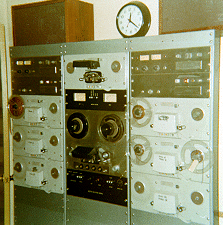
PAMS sent out thousands of copies of its "demo tapes" to potential clients. They were made in the dubbing room, using this rack of Ampex PR-10's. It could run at twice normal speed, and make six copies at once. The masters were usually run backwards, so that the copies would finish "heads out" and not have to be rewound. By 1972 this equipment was replaced with other Ampex decks that operated at four times normal speed.
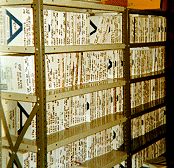
The dubbing room also housed the collection of "reference tapes". These were safety copies of every jingle package that PAMS recorded, and it took dozens of shelves to hold them all.
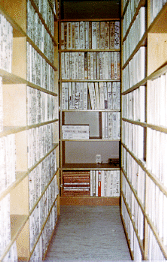
In 1972 the facility on Office Parkway was expanded. One of the improvements was an enlarged dubbing room, with custom built shelves to hold the master tapes and reference dubs. If you wanted to collect all the station ID packages that PAMS did in the '60s and '70s, you would need at least five times the amount of space shown here!
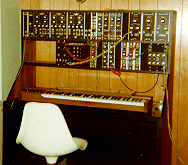
PAMS bought one of the very first Moog synthesizers, which revolutionized the sound of jingles beginning with Series 32 in 1966. Bill Meeks met Robert Moog at an AES convention and placed an order shortly thereafter, but initially had a hard time convincing the writers to make use of this strange new device.
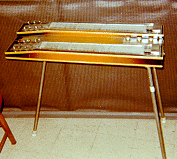
One of the other instruments which gave many PAMS jingles a distinctive sound was this "console guitar", which was usually played by staff writer and musician Ray Hurst. It's similar to a steel guitar without foot pedals, and was responsible for all those "slide" effects which were heavily used in packages like Series 18, 22, and 27, as well as later with acappellas.
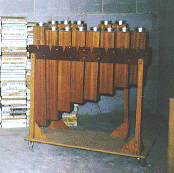
PAMS was always looking for unique and unusual sounding instruments. Here you see the "boobams". This was actually a set of small tuned drums. There was one drum for each note of the scale so you could play melodies and logos. You stood in front of the set and played it with your hands, similar to the way bongo drums are played. (Today all this would probably be done using a MIDI keyboard and sampler.) The boobams were used extensively in series 26, among many others.
Photos on this page by Peter Mokover and Ken Justiss. Rights to all photos are reserved by their respective owners.
|
|
|
|
|
|